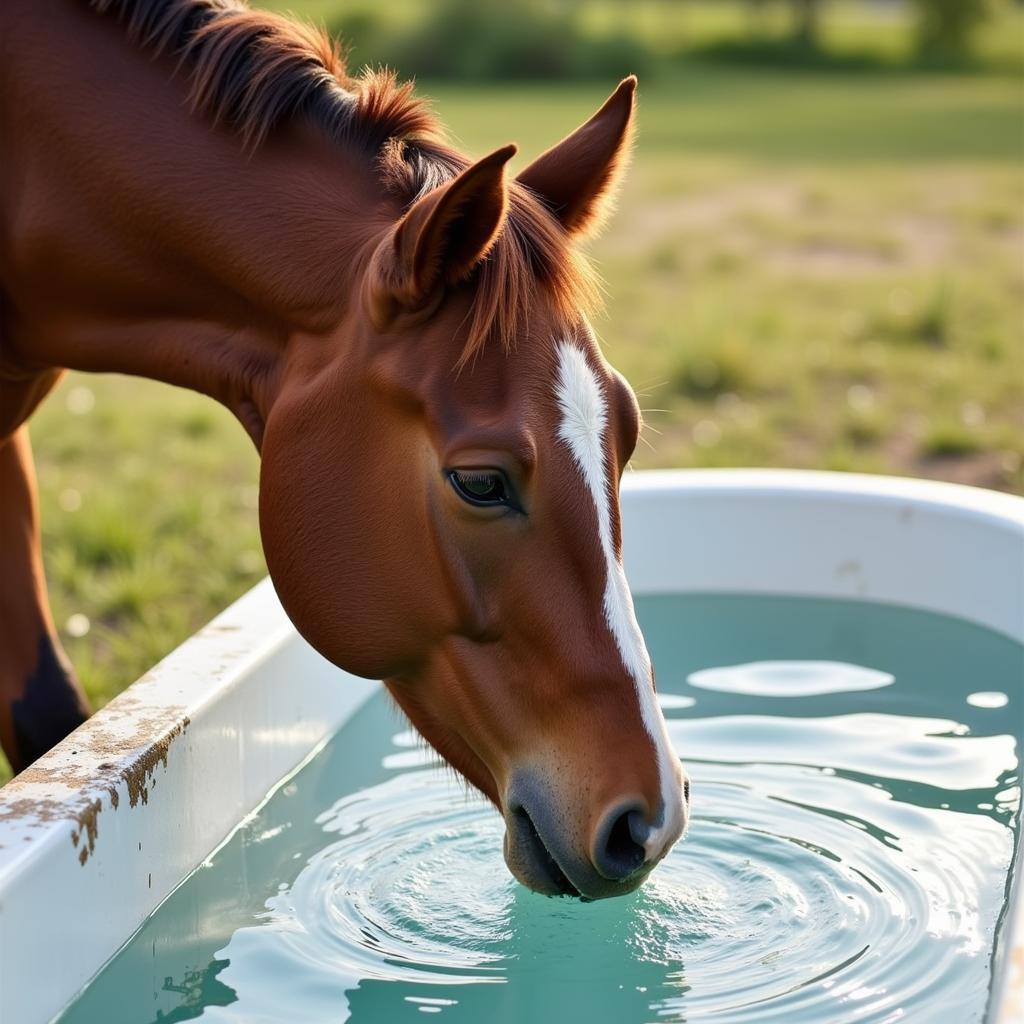Mineral Licks For Horses are essential for providing them with the necessary minerals and trace elements they may be lacking in their diet. These supplements can significantly impact a horse’s overall health, performance, and well-being. Understanding the different types of mineral licks, their benefits, and how to choose the right one is crucial for every horse owner.
Why Are Mineral Licks Important for Horses?
Horses require a balanced diet consisting of forage, grains, and supplements to ensure they receive adequate amounts of vitamins and minerals. However, even with a seemingly complete diet, horses can sometimes become deficient in certain essential minerals, especially if their forage is grown in mineral-deficient soil. This is where mineral licks come in. They provide a free-choice source of essential minerals, allowing horses to self-regulate their intake based on their individual needs. Providing access to loose salt and minerals for horses can help ensure they are receiving a complete and balanced nutritional intake.
Different Types of Mineral Licks for Horses
Mineral licks come in various forms, including blocks, granules, and loose minerals. Each type has its advantages and disadvantages. Block licks are the most common and convenient, while granulated licks are less prone to weathering and waste. Loose mineral supplements offer more flexibility in terms of customizing the mineral profile. Choosing the right one depends on your horse’s specific needs, your budget, and your management practices. For more information on related topics, see our article on redmond garlic salt for horses.
Choosing the Right Mineral Lick for Your Horse
Selecting the appropriate mineral lick for your horse requires careful consideration of several factors, including their age, activity level, breed, and overall health. For example, growing horses, pregnant mares, and performance horses have different mineral requirements compared to mature, non-working horses. Consult with your veterinarian or an equine nutritionist to determine the best mineral supplement for your horse’s individual needs. They can assess your horse’s diet and recommend a mineral lick that addresses any deficiencies.
What Minerals Should a Horse Mineral Lick Contain?
Essential minerals for horses include salt, calcium, phosphorus, magnesium, potassium, copper, zinc, selenium, and iodine. The specific proportions of these minerals in a lick will vary depending on the intended use and the region where the lick is sold. Some mineral licks also contain added vitamins or other nutrients, such as probiotics or prebiotics. Ensure the mineral lick you choose provides a balanced and appropriate blend of minerals to support your horse’s health and well-being. You might also find our article about horse licking informative in understanding this behavior further.
How to Introduce a Mineral Lick to Your Horse
Introducing a new mineral lick to your horse should be done gradually. Initially, offer the lick alongside their regular feed and salt to prevent overconsumption. Monitor their intake and adjust accordingly. Some horses may be hesitant to try a new lick, so offering it in different forms, such as loose or block, can encourage them to explore it. If you notice excessive licking or chewing, consult your veterinarian to rule out underlying health issues or mineral imbalances. Our article on chew toys for horses might offer additional ways to satisfy your horse’s chewing needs.
“Mineral licks are an easy and effective way to ensure horses receive the necessary minerals they need,” says Dr. Emily Carter, DVM, specializing in equine nutrition. “They are especially beneficial for horses grazing on pastures with known mineral deficiencies.”
 Horse Drinking Water After Using Mineral Lick
Horse Drinking Water After Using Mineral Lick
Placement and Maintenance of Mineral Licks
Place mineral licks in a dry, sheltered area accessible to all horses in the pasture. Ensure the area is clean and free from manure or other contaminants. Regularly check the lick for wear and tear and replace it as needed. Over time, mineral licks can become contaminated with dirt or debris, so maintaining cleanliness is vital. Additionally, always provide fresh, clean water alongside mineral licks, as they can increase thirst. Consider our thirst quencher for horses for optimal hydration solutions.
“Proper placement and maintenance of mineral licks are just as important as choosing the right one,” adds Dr. Sarah Jones, PhD, an equine nutrition researcher. “A clean and accessible lick encourages proper intake and minimizes the risk of contamination.”
Conclusion
Mineral licks for horses are a valuable addition to a balanced equine diet. They play a critical role in providing essential minerals that may be lacking in forage and contribute to a horse’s overall health and performance. Choosing the appropriate type of mineral lick and ensuring proper placement and maintenance are crucial steps for maximizing its effectiveness. By providing access to mineral licks, you can help your horse thrive and maintain optimal health.
FAQs
- How often should I replace my horse’s mineral lick?
- Can mineral licks be harmful to horses?
- What are the signs of mineral deficiency in horses?
- Can I give my horse too many minerals?
- Are all mineral licks the same?
- Do mineral licks help with coat health?
- Can I use mineral licks for other livestock?
Need assistance with your horse’s mineral needs? Contact us! Phone: 0772127271, Email: [email protected] or visit us at QGM2+WX2, Vị Trung, Vị Thuỷ, Hậu Giang, Việt Nam. We have a 24/7 customer support team ready to help.